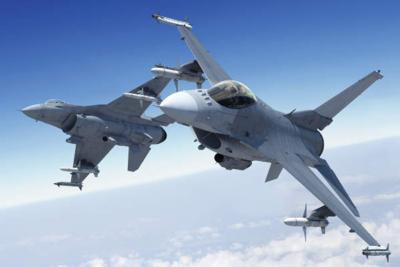USAF Report Ascribes March 2022 Accident to Pilot Error
Compelled by the incorrect belief that he’d lost control of his F-16 during a training exercise, a USAF Air National Guard pilot ejected from the aircraft over western Louisiana. The incident resulted in the destruction of the $27-million fighter jet—so states a newly-released USAF Accident Investigation Board report.

Subject report faults the pilot and the flight-lead by whom he was accompanied for failing to follow Air Force rules and regulations during their attempted practice-intercept of a civilian aircraft neither aware of nor participating in the exercise.
According to the report, the 23 March 2022 accident marked the unplanned and inauspicious end of what was to have been a routine flight-training exercise simulating a NORAD mission comprising an Aerospace Control Alert (ACA).
Aerospace Control Alert operations encompass those actions required to maintain peacetime control of U.S. and Canadian airspace.
During the training exercise, the two F-16s—after departing Texas’s Ellington Field Joint Reserve Base—encountered a civilian aircraft established in an IFR holding-pattern under the auspices of the local Air Traffic Control (ATC) authority.
Neglecting to contact the civilian aircraft or the ATC agency, the flight-lead pilot ordered an unplanned low-and-slow Visual Identification (VID) intercept of the former—thereby violating Air Force training regulations requiring such intercepts to be coordinated beforehand for purpose of ensuring the flight-crew of the aircraft being intercepted refrains from maneuvering unpredictably.
“As a result [of the impromptu intercept], the [civilian] aircraft conducting an instrument holding pattern at Beauregard Regional Airport resulted in multiple unpredictable turns. These uncoordinated turns further increased the level of difficulty for the [F-16s] during their intercept,” the report states.
As the F-16s performed the intercept, both pilots flew their aircraft slower than USAF training minimums for the altitude. The flight-lead identified five of the civilian aircraft’s six tail-number digits. The second pilot subsequently approached to determine the missing digit, but in so doing committed another infraction of USAF training regulations by nearing to within three-hundred-feet of the civilian aircraft.
As the second pilot gleaned the missing digit and completed the intercept, he attempted to raise his F-16’s trailing edge flaps using the Alternate Flaps switch. Regrettably, the lad inadvertently selected the Digital Backup switch located adjacent the Alternate Flaps switch. The error caused the F-16’s fly-by-wire flight control laws to default to their false [not active] state, irrespective of the jet’s actual airspeed.
The trailing edge flaps commenced retracting, a normal occurrence indicative of a correctly functioning flight control system—when the DBU switch has been activated. The shudder resultant of the flaps’ retraction led the F-16 pilot to mistakenly conclude his aircraft had departed controlled flight, and prompted him to erroneously activate the fighter’s ejection seat.
The interval between the pilot’s flipping of the DBU switch and initiation of the ejection sequence spanned a brief four seconds—according to the report.

Pilotless and forlorn, the F-16 tumbled earthward, impacting the ground in a steep, slow, upright approach and possible rotation. An image included in the report shows the fighter’s wreckage strewn over several hundred square-meters of sparsely-wooded, uninhabited, Louisiana brushland. Only a few pieces of the F-16 remain identifiable.
The AIB’s report identified the accident’s principal cause as the pilot’s failure to effectively maintain positive control of his aircraft throughout the low-speed, low-altitude environment. The board concluded that the pilot’s mistaken belief that his aircraft had departed controlled flight was attributable to his inadvertent manipulation of the DBU switch and lack of familiarity with the F-16’s handling characteristics.
The report went on to assert that the pilot and flight lead’s decision to involve a non-participating civilian aircraft in a training exercise contributed substantially to the accident, as did their individual and collective failures to follow Air Force regulations governing airspeed, aircraft in-flight separation, and training mission pre-flight briefings.
More broadly, in interviewing witnesses from the 138th Fighter Wing’s Detachment 1 at Ellington Field, the author of the AIB report found that many members of the squadron could not state with certainty whether or not performing low/slow Visual Identification intercepts against nonparticipating and uncoordinated aircraft is a permitted USAF practice.
 ANN's Daily Aero-Term (04.26.24): DETRESFA (Distress Phrase)
ANN's Daily Aero-Term (04.26.24): DETRESFA (Distress Phrase) ANN's Daily Aero-Linx (04.26.24)
ANN's Daily Aero-Linx (04.26.24) Airborne 04.22.24: Rotor X Worsens, Airport Fees 4 FNB?, USMC Drone Pilot
Airborne 04.22.24: Rotor X Worsens, Airport Fees 4 FNB?, USMC Drone Pilot Airborne 04.24.24: INTEGRAL E, Elixir USA, M700 RVSM
Airborne 04.24.24: INTEGRAL E, Elixir USA, M700 RVSM Airborne-NextGen 04.23.24: UAVOS UVH 170, magni650 Engine, World eVTOL Directory
Airborne-NextGen 04.23.24: UAVOS UVH 170, magni650 Engine, World eVTOL Directory




